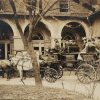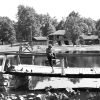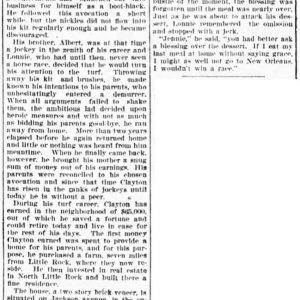calsfoundation@cals.org
Alonzo "Lonnie" Clayton (1876–1917)
Alonzo “Lonnie” Clayton reached stardom at age fifteen as the youngest jockey to win the Kentucky Derby. An African American, Clayton went on to become one of the highest-salaried riders on the East Coast circuit during the 1890s. He lived in North Little Rock (Pulaski County), where his earnings enabled him to build a Queen Anne–style home that the Arkansas Gazette described as the “finest house on the North Side” in early 1895. Surviving as the historic Engelberger House at 2105 Maple Street, the property (named for Swiss immigrant Joseph Engelberger, who bought it in 1912) was listed on the National Register of Historic Places in 1990.
Born in 1876 in Kansas City, Kansas, to Robert and Evaline Clayton, Lonnie Clayton was ten when he moved with his parents and eight siblings to North Little Rock. His father was a carpenter. Although Clayton had to work as a hotel errand boy and a shoeshine boy to help pay the bills, he attended school and was considered “exceptionally bright,” a correspondent for the Thoroughbred Record wrote in 1896. At age twelve, Clayton ran away from home to join his brother, Albertus, a jockey who rode for Elias J. “Lucky” Baldwin in Chicago. Clayton started as an exercise rider and debuted as a jockey in Clifton, New Jersey, in 1890. Later that year, he claimed the first of many victories.
The next year, he won the prestigious Jerome Stakes and the Champaign Stakes at Morris Park in Westchester County, New York. Following his Kentucky Derby triumph in 1892, he added impressive victories in the Clark Stakes at Churchill Downs in Louisville and the Travers Stakes at Saratoga, New York. He competed in three more Kentucky Derbies, finishing second in 1893 and 1897 and third in 1895. During his peak in 1895, he posted 144 wins and finished in the money on sixty percent of his mounts at tracks across the country. In 1895, he won the Arkansas Derby at the Little Rock Jockey Club’s Clinton Park. To date, Clayton is still one of only three black jockeys ever to compete in the Preakness in Baltimore, where he finished third in 1896.
While spending most of his time on the road, Clayton, who never married, came back to North Little Rock regularly to visit family. He bought his parents a farm in 1894 in what is now Sherwood (Pulaski County) and had the Queen Anne–style house built in 1895. He also built a two-story commercial building on Main Street in North Little Rock in 1897. His celebrity status spawned a legend that erroneously linked him to another Queen Anne house, known today as the Baker House, a bed and breakfast at 109 West 5th Street in North Little Rock. According to legend, Clayton, misidentified as Artemis E. Colburn, raced horses in England and came back to his hometown of Argenta (now North Little Rock) to build a grand house; however, he soon left the area.
The reason for the Claytons’ departure is not clear, but in a larger context racism did contribute. In the early 1900s, bigotry drove black jockeys out of the sport they had dominated in America since the mid-1600s. Most stable owners stopped hiring them when sanctions, and even physical threats against black jockeys, increased. Some went overseas, as Clayton may have done.
Clayton and his family lived in the future Engelberger House from 1895 to 1899. Confirming this fact is Clayton’s nephew, Clayton Westbrook of Los Angeles, who retained a photo of his mother, Bessie (Lonnie Clayton’s youngest sister), and other family members in front of the house. Moreover, written in pencil in the attic are the names of Clayton and eight brothers and sisters, as well as “Mama and Papa Clayton” and “1899” and “Goodbye.” On a baseboard to the right is a drawing of what appears to be a jockey, under which is written “Ragtime Jimmie,” the meaning of which is unknown.
At his last big-time appearance, Clayton was arrested in April 1901, shortly before post time at the Aqueduct track in New York for allegedly fixing a race. Despite dismissal of the charge, his career was effectively finished. He did attempt comebacks in 1902 in Montana and in 1904 in Memphis, but he never again won a major race. A wave of anti-gambling legislation in the 1900s also shut down many tracks and limited opportunities for jockeys.
Clayton lived his last few years in California and died at age forty-one on March 17, 1917, of chronic pulmonary tuberculosis. He is buried at Evergreen Cemetery in Los Angeles.
For additional information:
Alonzo Clayton File. North Little Rock History Commission, North Little Rock, Arkansas.
“Engelberger House.” National Register of Historic Places nomination form, 1990. On file at Arkansas Historic Preservation Program, Little Rock, Arkansas. Online at http://www.arkansaspreservation.com/!userfiles/PU3307.nr.pdf (accessed January 17, 2023).
Hotaling, Edward. The Great Black Jockeys. Rocklin, CA: Prima Publishing, 1999.
Mooney, Katherine C. Race Horse Me: How Slavery and Freedom Were Made at the Racetrack. Cambridge, MA: 2014.
Saunders, James Robert, and Monica Renae Saunders. Black Winning Jockeys in the Kentucky Derby. Jefferson, NC: McFarland & Company, 2003.
Cary Bradburn
North Little Rock History Commission
 Post-Reconstruction through the Gilded Age, 1875 through 1900
Post-Reconstruction through the Gilded Age, 1875 through 1900 Recreation and Sports
Recreation and Sports "Lonnie" Clayton Article
"Lonnie" Clayton Article 



Comments
No comments on this entry yet.